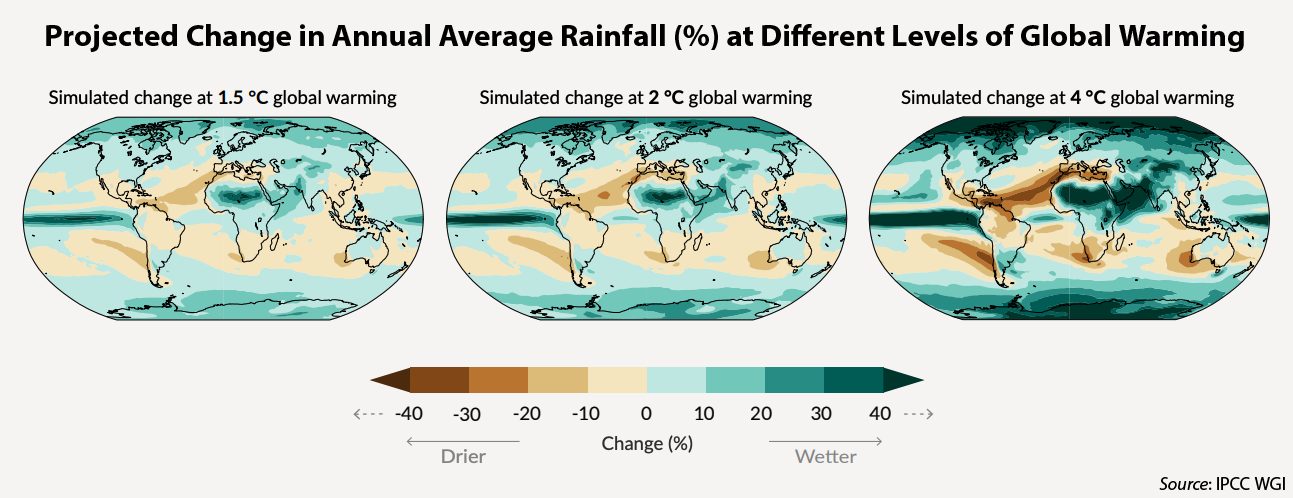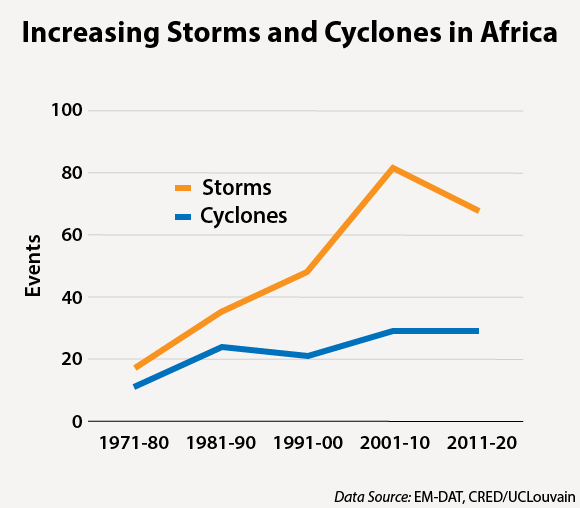
A street in Buzi, Mozambique, flooded after Cyclone Idai in March 2019. (Photo: AFP/Adrien Barbier)
More Rain…
- The Intergovernmental Panel on Climate Change predicts that, as a result of global warming, the frequency and intensity of heavy rainfall events will increase for most of tropical Africa (while parts of northern and southern Africa will become drier). This translates into a significantly increased risk of flooding.
- Runoff in the Congo River basin, for example, is projected to increase by 50 percent, elevating flooding risks, especially flash flooding, across large parts of Central Africa.
- Rising global temperatures, based on their current trajectory, are also expected to increase rainfall in parts of the Greater Horn of Africa by over 40 percent. Extraordinarily heavy rains in East Africa in recent years have contributed to the worst desert locust outbreak to hit the region in the past 25 years.
- Scientists have shown that for every 1 degree Celsius increase of warming, the atmosphere can hold 7 percent more moisture. This means that warm conditions make storms much wetter, leading to record-breaking rainfall.
… and Stronger Storms
- Global warming also increases sea surface temperature. This packs more energy into storms that develop over the oceans, generating more intense rainfall and higher wind speeds, making them more damaging.
- As oceans have warmed, Africa has experienced four times as many storms and more than a doubling in the number of cyclones since the 1970s. This equates to an average of 3 cyclones coming off the Indian Ocean each cyclone season, which typically runs from November through March. During the 2021-2022 season, there were six.
- With warmer ocean temperatures and more energy driving each storm, tropical cyclones from the Indian Ocean are also making landfall over a wider swath of Africa’s east coast. Beyond historical paths affecting Madagascar and rural northern Mozambique, the cyclones are expected to push into latitudes farther north (encompassing Tanzania) and south (including South Africa).
- These cyclones are more likely to impact more densely populated urban areas such as Maputo, Durban, and Dar es Salaam. A direct hit on one of these urban areas could affect millions of people and cause acute economic costs.
- Illustratively, Cyclone Idai, in March 2019, was unprecedented. It was the deadliest (causing over 1,000 deaths) and the most costly (around $3.25 billion) cyclone ever to hit Africa. The following month, Cyclone Kenneth was the strongest cyclone ever recorded on the continent with winds peaking at 225 kph (140 mph) and floods reaching 2.5 m above normal water levels.
More Severe Flooding and Landslides
- More frequent and intense rainfall and storms lead to more inland and coastal flooding. Rain-related natural disasters in Africa have grown nearly tenfold over the last 50 years.
- Since 2000, floods have accounted for 66 percent of disasters recorded in Africa. These have been concentrated in East Africa with South Sudan, Sudan, Somalia, Ethiopia, and Kenya regularly among the African countries having the largest numbers of people affected by floods. Reflective of the unpredictability of flooding from year-to-year, this list varies greatly and countries from West Africa (e.g., Nigeria, Ghana, and Niger) as well as southern Africa (Malawi and Angola) are also, at times, seriously impacted.
- Sub-Saharan Africa is the only region in the world that has recorded increasing rates of flood-related mortality since the 1990s. In 2020, floods affected 8.1 million people and caused 1,273 deaths.
Intensifying Storms Will Exacerbate Human Security Risks in Africa
- Stronger storms have had devastating effects on crops, homes, and infrastructure.

A washed out road south of Beira, Mozambique. (Photo: AFP/Adrien Barbier)
- Increased flooding also increases the spread of vector-borne diseases—such as malaria, yellow fever, dengue, Zika, and Rift Valley Fever. In South Sudan, there were an estimated 800,000 cases of malaria, diarrhea, and snake bites after the unprecedented floods of 2021.
- At 1.5°C of global warming, distribution and seasonal transmission of vector-borne diseases is expected to increase, exposing tens of millions more people, mostly in East and Southern Africa.
- Climate disasters are compounding challenges in conflict-affected areas. Conflict has simultaneously hindered many countries’ ability to focus on disaster preparedness and adaptation to climatic changes. This is contributing to a vicious circle of poor governance, conflict, and climate disaster. Floods add to already record levels of refugees and internally displaced due to conflict.
- The impact of climate-related disasters is arguably worse than recognized due to chronic underreporting of losses from disasters, particularly with regard to small-scale disasters, which cumulatively can be just as damaging as large-scale disasters.
- Helping vulnerable communities design solutions to adapt and to mitigate the effects of stronger and more frequent storms will be of growing importance to human security in Africa. Disaster risk reduction lessons and early warning system installations in places like Beira, Mozambique will result in more lives saved and faster recovery from disasters. Community risk mapping, such as what was done in Dar es Salaam, Tanzania and Kisumu, Kenya, provide the data necessary to develop more effective disaster risk mitigation (DRM) and disaster risk reduction (DRR) plans.
Disaster Risk Reduction Lessons from Africa
Even before Cyclone Idai hit the city of Beira and its 500,000 inhabitants, its mayor was already working on a plan to make the city flood-resistant by 2035. Despite the mayor’s proactive antiflooding efforts, however, the 105-mph winds of Cyclone Idai proved more than the city could handle. It left an estimated 90 percent of the city damaged. Though the storm wreaked havoc on the landscape—tearing roofs from homes, leveling trees and powerlines—the mayor’s flood resistance efforts were successful. The water quickly receded in those parts of the city where the canals had been refurbished, allowing people to clean up and return home sooner. Looking forward, the city government, with support from international partners, has plans to improve housing, expand the canal system throughout the city, and fortify the city’s shoreline as part of a disaster risk reduction plan.
Tanzania’s capital, Dar es Salaam, is one of Africa’s fastest growing cities. Most of that growth has been unplanned. As a result, being a coastal city, it is prone to increasing incidents of flooding. A community risk mapping project called Ramani Huria was launched in 2015. By October 2018, Ramani Huria had mapped over 228 communities of roughly 3.5 million residents, generating geospatial information on land use, infrastructure, and exposure. All that data has informed the DRM and DRR plans for the city. In the process, the collaboration between a broad spectrum of stakeholders—local academic institutions and NGOs, the Tanzanian Commission of Science and Technology, the Tanzania Red Cross Society, and the World Bank, among others—has led to increased receptivity to required changes in behavior and greater understanding of underlying causes of disaster risk.
The port city of Kisumu in Kenya may be another model for other cities interested in learning how to design DRR plans. With support from the United Nations Office for Disaster Risk Reduction, over 100 participants from Kisumu’s municipal departments and local organizations and communities developed their first DRR action plan in 2018. Situated on the shores of Lake Victoria, Kisumu is prone to flooding during the heavy seasonal rains. Before, the city would wait for the floods and then render the necessary humanitarian response. Since the DRR consultations, the emphasis moved from being reactive to proactive in preparing for and mitigating the effects from flooding. Key to Kisumu’s success has been civic engagement and participation. In addition to improving the city’s drainage infrastructure and keeping storm drains clear, the community focused on replacing a frequently flooded bridge that connected downtown to the rest of the community.
Additional Resources
- Africa Center for Strategic Studies, “Climate Change and Security in Africa,” Roundtable, March 7, 2022
- Africa Center for Strategic Studies, “How Global Warming Threatens Human Security in Africa,” Infographic, October 29, 2021.
- Intergovernmental Panel on Climate Change (IPCC), “Climate Change 2022: Impacts, Adaptation and Vulnerability: Chapter 9 Africa,” United Nations, February 2022.
- Francois A. Engelbrecht, Pedro M.S. Monteiro, “The IPCC Assessment Report Six Working Group 1 report and southern Africa: Reasons to take action,” South African Journal of Science 117, no. 11-12 (2021).
- Africa Center for Strategic Studies, “National Security Strategy Development in Africa: Toolkit for Drafting and Consultation,” January 2021.
More on: Environment and Security







